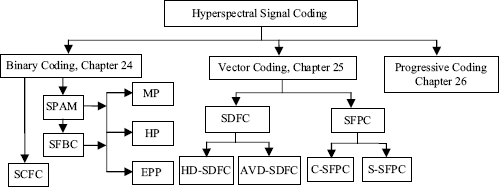VI
Hyperspectral Signal Coding
The second category of this book, Category B, is devoted to hyperspectral signal processing. The question is for a given data sample vector treated as a signature vector without reference to others, what is the best possible we can do to explore as much spectral information across the entire wavelength range to specify the data sample vector for spectral characterization. There are two ways to process hyperspectral signals either in a discrete manner as discrete signal processing referred to as signal coding in Part VI or in a continuous manner as continuous signal processing referred to as signal characterization in Part VII.
In Part VI, the focus is placed on hyperspectral signal coding that represents a signature vector by a discrete vector as a code word that can be considered as its fingerprint. A simplest way to accomplish this task is binary coding that binarizes each component of a signature vector for its identification. An earliest attempt was made by Mazer et al. (1988) to develop a so-called spectral analysis manager (SPAM) that encoded a remote sensing image data sample vector into a binary code vector for signature discrimination, classification, and identification. It calculates spectral mean and interband spectral difference and uses them as thresholds to generate a binary code word for a given hyperspectral signature vector. The SPAM binary coding was then extended to a spectral feature-based binary coding (SFBC) developed by Qian et al. (1996) who incorporated an additional binary code word produced by thresholding the spectral mean deviation to improve SPAM. Chapter 24 studies these two coding schemes and follows similar ideas to further design several new binary signature coding schemes, median partition (MP), halfway partition (HP), and equal probability partition (EPP). Since the coding schemes in Chapter 24 perform component-wise encoding in the sense that the spectral value at each wavelength is encoded separately and independently without taking advantage of spectral correlation among adjacent bands, they are memoryless coding and can be viewed as scalar coding in context of the source coding. Therefore, an obvious extension to scalar coding is vector coding. Chapter 25 investigates such an extension where two vector coding approaches to encoding hyperspectral signals are developed, called spectral derivative feature coding (SDFC), and spectral feature probabilistic coding (SFPC) where SDFC is derived by including spectral textures as features to account for spectral correlation among two successive adjacent bands and SFPC has its origin derived from arithmetic coding, which is a well-established coding method developed by Rissanen (1976) and Langdon and Rissanen (1981) and has been widely used in image coding.
One of major applications in hyperspectral signal coding is satellite data communication where data compression and transmission are critical and crucial. So, a progressive signature coding (PSC) Chapter 26 develops that allows signal coding to be progressive. In this case, hyperspectral signals can be encoded in a coarse-to-fine resolution manner. As a result, data transmission can take place more rapidly through each pass where each pass increases signal resolution for better data processing. The idea of PSC is similar to that used by progressive band selection (PBS) discussed in Chapter 23 where the coding process is carried out progressively in the exactly same way as band selection performed by PBS in the sense that the results produced by a previous process are always part of the following subsequent process to improve results. In PBS band prioritization (BP) is used to prioritize spectral bands so that progressive band dimensionality process (PBDP) is performed in band reduction or expansion. Unfortunately, such BP is developed for band images and is not applicable to signature coding. Therefore, a new coding scheme called multistage pulse code modulation (MPCM) is designed in Chapter 26 to encode a hyperspectral signal wavelength by wavelength progressively.
Figure VI.1 Topics of three chapters in Part VI.

Finally, Figure VI.1 shows the topics covered in three chapters in Part VI.
